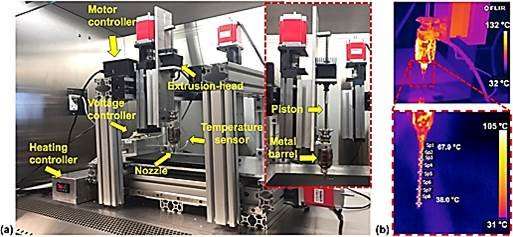August 13, 2018 feature
3-D printed biomaterials for bone tissue engineering

When skeletal defects are unable to heal on their own, bone tissue engineering (BTE), a developing field in orthopedics can combine materials science, tissue engineering and regenerative medicine to facilitate bone repair. Materials scientists aim to engineer an ideal biomaterial that can mimic natural bone with cost-effective manufacturing techniques to provide a framework that offers support and biodegrades as new bone forms. Since applications in BTE to restore large bone defects are yet to cross over from the laboratory bench to clinical practice, the field is active with burgeoning research efforts and pioneering technology.
Cost-effective three-dimensional (3-D) printing (additive manufacturing) combines economical techniques to create scaffolds with bioinks. Bioengineers at the Pennsylvania State University recently developed a composite ink made of three materials to 3-D print porous, bone-like constructs. The core materials, polycaprolactone (PCL) and poly (D,L-lactic-co-glycolide) acid (PLGA), are two of the most commonly used synthetic, biocompatible biomaterials in BTE. Now published in the Journal of Materials Research, the materials showed biologically favorable interactions in the laboratory, followed by positive outcomes of bone regeneration in an animal model in vivo.
Since bone is a complex structure, Moncal et al. developed a bioink made of biocompatible PCL, PLGA and hydroxyapatite (HAps) particles, combining the properties of bone-like mechanical strength, biodegradation and guided reparative growth (osteoconduction) for assisted natural bone repair. They then engineered a new custom-designed mechanical extrusion system, which was mounted on the Multi-Arm Bioprinter (MABP), previously developed by the same group, to manufacture the 3-D constructs.
The bone tissue constructs were designed using Mach3 software and printed thereafter. In the study, PCL/PLGA/HAp composite constructs were compared experimentally with PCL-only constructs to understand how changing the chemistry of materials contributed to bone-like mimicry.
The mechanical system was developed in-house to extrude PCL and the composite ink, using a metal nozzle and a mechanical extruder unit mounted on the MABP. An advanced temperature/process controller was used to maintain the temperature at the end of the metal nozzle tip, alongside a K-type thermocouple feedback sensor placed at the lower end of the barrel to regulate temperature during polymer deposition.
Microarchitectures of 3-D printed porous constructs were comparatively observed with scanning electron microscopy and tested thereafter for their chemical, mechanical and structural properties in the lab. The material's ability to support biological cells for proliferation was tested with cell-material interactions using bone marrow stem cells, visualized with immunostaining and fluorescent microscopy.
The capacity to differentiate into osteoblasts (bone-forming cells) during osteogenesis (bone development) was observed with RT-PCR by identifying specific genes of interest expressed by the cells during osteogenesis. The genes of interest included runt-related transcription factor 2 (RUNX2), osteocalcin (OCN also known as BGLAP) and alkaline phosphatase (ALP), associated with osteoblast differentiation.
The 3-D composite material (PCL/PLGA/HAp) showed improved cell proliferation and increased gene expression during bone regeneration compared with 3-D PCL. Comparatively improved osteogenic capacity of the 3-D composites was also validated after implantation in an animal model in vivo. The researchers observed increased rates of newly formed mineralized bone tissue after eight weeks with histology techniques.
The observation was credited to the material's composition, since greater surface wettability (hydrophilicity) and ingrained osteoconductive factors assisted better cell growth on the composite, compared to hydrophobic PCL by itself.
Extensive in vitro and in vivo investigations demonstrated that the composite ink developed in the lab for 3-D bioprinting was a promising material for BTE applications. The described biomimetic, cell and gene activating BTE materials are third-generation bone repair materials and remain an active area of research. Materials scientists are also focused on engineering and improving next-generation BTE materials that integrate the fourth dimension of time into 3-D constructs and in smart polymers to create four-dimensional polymers (4-D) for BTE applications in orthopedics.
More information: Kazim K. Moncal et al. 3-D printing of poly(ε-caprolactone)/poly(D,L-lactide-co-glycolide)/hydroxyapatite composite constructs for bone tissue engineering, Journal of Materials Research (2018). DOI: 10.1557/jmr.2018.111
A decade of progress in tissue engineering www.ncbi.nlm.nih.gov/pubmed/27583639 Khademhosseini A., and Langer R., 2016, Nature Protocols.
Towards 4-D printed scaffolds for tissue engineering: exploiting 3-D shape memory polymers to deliver time-controlled stimulus on cultured cells www.ncbi.nlm.nih.gov/pubmed/28726680 Hendrikson et al, 2017, Biofabrication.
Bone substitutes in orthopaedic surgery: from basic science to clinical practice. www.ncbi.nlm.nih.gov/pubmed/24865980 Campana et al, 2014, Journal of Materials Science, Materials in Medicine.
© 2018 Medical Xpress





















